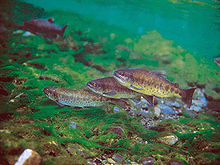Oncorhynchus masou formosanus
| Oncorhynchus masou formosanus | |
|---|---|

| |
| Scientific classification | |
| Domain: | Eukaryota |
| Kingdom: | Animalia |
| Phylum: | Chordata |
| Class: | Actinopterygii |
| Order: | Salmoniformes |
| Family: | Salmonidae |
| Genus: | Oncorhynchus |
| Species: | |
| Subspecies: | O. m. formosanus
|
| Trinomial name | |
| Oncorhynchus masou formosanus (D. S. Jordan & Ōshima, 1919)
| |
Oncorhynchus masou formosanus, commonly known as the Formosan salmon,[1] Taiwanese trout (Japanese: タイワンマス, romanized: taiwan masu), Tsugitaka trout (次高鱒, tsugitaka masu), Lishan trout (Chinese: 梨山鱒, after its native Lishan area in Heping District, Taichung) or Slamaw trout (from Slamaw, the indigenous Tayal name for Lishan), is an endangered freshwater fish endemic to the mountain stream valleys between the Xueshan and Central Ranges of Taiwan. It is the southernmost subspecies of masu salmon (Oncorhynchus masou), and one of the most temperately distributed salmonids along with the Mexican golden trout and Mexican rainbow trout.
Description
Adult Formosan salmon is about 30 cm (1 ft) in length, while juveniles are about 15 cm (5.9 in) long in average. It has a dark green body with a silver belly, with nine elliptical dark spots and 11-13 smaller black spots on each side of the body. The male display a dark red color on the side during mating seasons.[2]
Ecology
Formosan salmon inhabit cold, slow-flowing streams with gently sloping beds. Being a coldwater fish native to the subtropical Taiwan, the fish only thrive at elevations above 1,500 metres (4,900 ft) where the water temperature is consistently below 16 °C (61 °F), such as the Chichiawan Stream and the Kaoshan Stream (formerly named Hsuehshan Stream or Wuling Stream) in the upper reaches of the Dajia River, within the ranges of Shei-Pa National Park. It is a relictual subspecies of the once more widespread masu salmon, landlocked into the highland valleys by the warming of lower Dajia River after the end of the Last Ice Age. Currently, it represents the southernmost natural distribution of any members of the family Salmonidae in Asia.[citation needed]
The Formosan salmon is one of the rarest fish in the world, and the current population is critically endangered at high risk for extinction. It was once a dietary staple among Taiwanese aborigines like the Atayal people, who know this fish by several local names: bunban, mnbang and n'bang.[3]: 116, 157 Overfishing has led to its decline. It is now a protected species in its native habitat, and conservationists are trying to save the subspecies, which is threatened nowadays mainly by water pollution. By 1992, there were only 200 remaining according to official count. Over the next 20 years, the Taiwanese government, the Shei-Pa National Park Administration, as well as effective conservation efforts in Taiwan, restored the fish population to historical high of 12,587 in 2020.[4] In March 2023, the number of fish once again reached new heights since restoration first started in 1995, with 15,374 counted by the Shei-Pa National Park Administration.[5][6]
Taxonomy
The taxonomic rank of the endemic Taiwanese salmon is in dispute.[7] Some authors consider it not distinct from the nominate cherry salmon (O. masou masou), others as a regional subspecies O. masou formosanus, and still others list is as a full species O. formosanus.[citation needed]
Popular culture
The salmon is featured on the NTD $2,000 bill.[6]
See also
Notes
- ^ Yan HY (2000) Threatened fishes of the world: Oncorhynchus masou formosanus (Jordan & Oshima, 1919) (Salmonidae) Environmental Biology of Fishes 57:314.
- ^ "櫻花鉤吻鮭". 臺灣魚類資料庫. Retrieved 2023-09-11.
- ^ Gao Richang (December 2008). 雪霸國家公園鄰近地區(尖石、大同等)泰雅族口述歷史訪談暨部落發展規劃 [Investigation of the relationship between Taiwan cherry hooked salmon and tribal culture——Taking the Huanshan Tribe in Heping District, Taichung City and the Nanshan Tribe in Datong Township, Yilan County as examples] (PDF) (Report) (in Chinese). 內政部營建署雪霸國家公園管理處 Taiwan Institute of Indigenous Peoples.
- ^ 吳, 姿賢. "復育有成 櫻花鉤吻鮭數量創新高". udn.com. 聯合報. Retrieved 19 June 2022.
- ^ 胡, 蓬生. "台灣櫻花鉤吻鮭 野外數量創新高". udn.com. 聯合線上公司. Retrieved 15 March 2023.
- ^ a b Jui-ping, Kuan; Mazzetta, Matthew (16 March 2023). "Formosan landlocked salmon population reaches record high". focustaiwan.tw. Focus Taiwan. Retrieved 16 March 2023.
- ^ Kottelat, M. (1996). "Oncorhynchus formosanus". IUCN Red List of Threatened Species. 1996: e.T15323A4513507. doi:10.2305/IUCN.UK.1996.RLTS.T15323A4513507.en. Retrieved 16 November 2021.
References
- Froese, Rainer, and Daniel Pauly, eds. (2010). Oncorhynchus masou formosanus in FishBase. April 2010 version.


